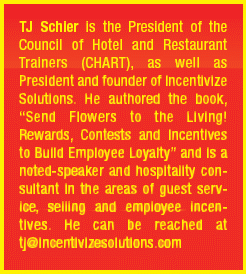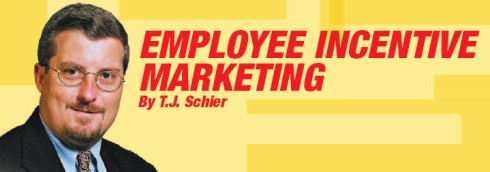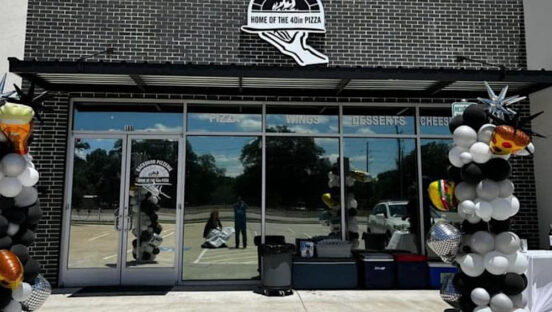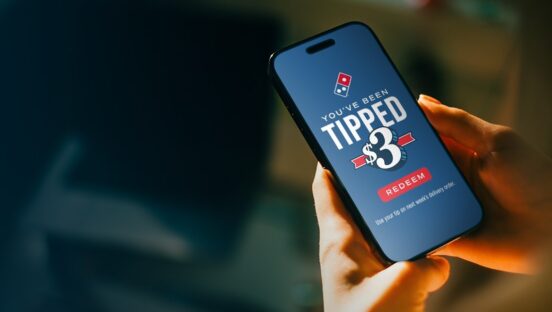As pizza chains and independents continue to battle for market share and the consumer's dollar, perhaps a focus inward may provide a more profitable strategy.
It is far cheaper to retain or up-sell an existing customer than attract a new one. The key lies in rewarding the performers, as well as having a collaborative operational and marketing strategy.
We've all seen the past successes of advertising new products, or even adding a message to your on-hold or automatedattendant message. FSI coupons, flyers and door hangars may get the message out, the on-hold message or in-store signage may plant another seed, but it is ultimately up to the employee to "seal the deal." How many times do we drop the ball after all our other efforts? Today's employees need an extra incentive. Think it may be impossible to get them to sell? Think again.
Designing a reward system which provides points or incentives to those selling above historical averages will not only drive incremental sales without having to attract new business, it aligns rewards with performance and will keep your good employees with you. Modifying a sign in my dentist's office which read, "You don't have to floss all your teeth, only the ones you want to keep," to "You don't have to recognize and reward all your employees, only the ones you want to keep," forces you to take a new approach to your people.

If the employees who sell more earn more, whether through a points program, rewards or gift certificates, they will increase the sales in your business. The same approach can also be taken in the kitchen by rewarding the employees who help us control costs, cook times and product presentation. Keeping the good employees is the key to driving your business. To be fair to your weak employees, let them go work for the competitor!
CONTEST EXAMPLE
A large national pizza chain wanted to drive sales of extra cheese on their pizza (as an additional topping). Their historical average was 10 percent of pizzas ordered actually had extra cheese. For a large pizza, the additional topping costs customers $1.60. At an average cost of 10 cents per ounce, the cost of the cheese was $1.00, generating an incremental profit of 60 cents.
We designed a system where the cashiers received points for every extra cheese topping sold over the 10 percent benchmark. The cashiers could then save the points for prizes. Essentially, they received the equivalent of a $10 prize for every additional $100 in profits they generated.
The managers of the top selling stores were also rewarded with trips and prizes. The result? The top-selling store was selling over 50 percent of their pizzas with extra cheese and the overall average was 20 percent – a doubling of extra cheese sales prior to the contest! Additionally, employee retention increased 20 percent, as they received rewards not offered by the competitors!
The cynic in you is now saying, "Yeah, but what happens after the contest ends?" Once the contest was over, the results did decrease, but were still above the past levels, so the benefits of the program continued even after the contest had ended, as we had developed behaviors.
The same approach can be used for the employees who take orders on the phone, or servers if you are full-service, or to sell new appetizers or other food items. Obviously, if you offer deals with multiple toppings, you won't want your cashiers offering extra cheese when you are not receiving any revenue, so modify the program for your specific needs.
THE MARKETING/OPERATION PARTNERSHIP
 Having the employees be able to sell our products is only part of the equation. You need to leverage the efforts of marketing and operations to maximize the potential. Whatever program or product you are featuring should be supplemented with an incentive program as previously outlined. Develop your sales training script tied to an incentive which rewards employees for selling the product you are featuring and implement it in conjunction with any marketing efforts you are utilizing. One hundred dollars spent on employees in a manner as described above may generate a far greater return than $100 of advertising.
Having the employees be able to sell our products is only part of the equation. You need to leverage the efforts of marketing and operations to maximize the potential. Whatever program or product you are featuring should be supplemented with an incentive program as previously outlined. Develop your sales training script tied to an incentive which rewards employees for selling the product you are featuring and implement it in conjunction with any marketing efforts you are utilizing. One hundred dollars spent on employees in a manner as described above may generate a far greater return than $100 of advertising.
Today's consumer is tired of the worn out, "Would you like to try our _____?" Any yes/no type of question we force our employees to ask is just a negative response (and a guest's sigh) waiting to happen.
A simple re-phrasing of these types of questions can greatly increase the odds of a successful sale. Avoid yes/no questions. Replace old, tired, ineffective phrases to some of the following: "Would you like to try our new buffalo wings?" with "We are featuring our new buffalo wings as well as our top-selling breadsticks, which would you prefer?" or "Would you like to add a second pizza to your order?" with "We are offering additional pizzas for only $4 more. How many would you like?"
Coupling these new sales lines on your dine-in or phone-in orders with your marketing efforts will drive your sales far greater than marketing alone, or those tired old sales lines.
EFFECTIVE INCENTIVES
The program has been developed, the sales training has been created, but you still need some prizes. Which rewards are the most effective? Cash? Studies have shown time and time again that cash works great to attract new employees, but is NOT the most effective motivator. After all, if it were, all servers would suggestively sell to every table as they are receiving 15 percent of all additional sales. Trouble is, they cannot brag about it (no trophy value) and they simply spend it without thinking about where they received it.
If money does not work, what does today's employee want? The most effective rewards to drive performance (and your business) include:
- Time off – everything from an extra 15 or 30 minutes to a paid day off
- Thank them!
- Gift certificates/cards to other restaurants (may be able to trade out to lower your costs)
- Gas Cards
- Phone Cards – international calling cards work great for employees with relatives outside of the country
- Electronic items • Lottery tickets for the weekly jackpot • Logoed items (yours or your vendors)
- Websites – Offer a choice from over 700 different gift certificates to websites
 While many of these items essentially are equivalent to cash, the employee will remember who gave it to them when they use it. This can drive your business with minimal risk or investment. Does it cost money? Yes, but only if it generates additional sales! What advertising or promotion can provide expenses only if sales are generated? Also, talk with your vendors to see if they will contribute prizes or money to help fund the contest. After all, you are helping to sell more of their product!
While many of these items essentially are equivalent to cash, the employee will remember who gave it to them when they use it. This can drive your business with minimal risk or investment. Does it cost money? Yes, but only if it generates additional sales! What advertising or promotion can provide expenses only if sales are generated? Also, talk with your vendors to see if they will contribute prizes or money to help fund the contest. After all, you are helping to sell more of their product!
THE FINAL KEY
Contests and programs are a great way to generate excitement and shortterm spikes in sales and employee retention, but ultimately, your success is based on the ability to create a recognition-culture where you recognize people's value to the organization. You not only owe it to your stars to reward them for their contributions, but also to rid your restaurant of the non-performers.
You will still have turnover, but you will be losing the right people. Lose a superstar and your business suffers. If a below-average performer leaves, your team's performance will most likely increase.













